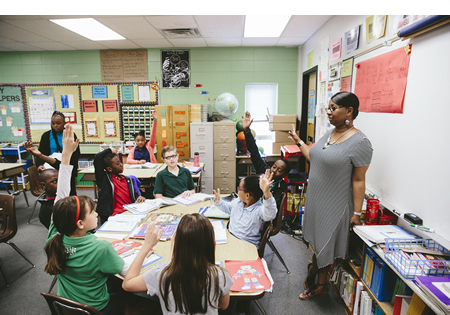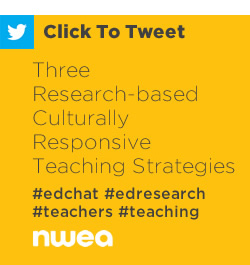U.S. public schools are becoming increasingly diverse, yet teachers of color continue to make up less than 20% of our teacher workforce. Here in Multnomah County in Portland, David Douglas School District (DDSD) is home to 10,000 students, 76% of whom qualify for free or reduced lunch, 45% of whom are English Language Learners, and more than 60% are students of color.
However, 90% of the district teachers are white. While increased recruitment and retention efforts to attract teachers of color are underway, DDSD is also focusing on implementing culturally responsive teaching practices this academic year.
David Douglas represents over 75 different languages from across the globe. Welcoming every student and pronouncing their name correctly was the first step in demonstrating care and fostering positive relationships,” says Brooke O’Neill, Director of Curriculum & Instruction, David Douglas School District.
 David Douglas posed this problem of practice to the Multnomah County Partnership for Education Research (MCPER). The partnership, which was developed by the University of Portland School of Education and NWEA, provides real-time research and program evaluation services to local school districts, long-term research support, and builds capacity for sustained research by the preparation of doctoral candidates working within these districts. Together, the partnership entities began investigating culturally relevant pedagogy and what specific practices might be most high-leverage to meet the academic needs of the changing demographics in David Douglas.
David Douglas posed this problem of practice to the Multnomah County Partnership for Education Research (MCPER). The partnership, which was developed by the University of Portland School of Education and NWEA, provides real-time research and program evaluation services to local school districts, long-term research support, and builds capacity for sustained research by the preparation of doctoral candidates working within these districts. Together, the partnership entities began investigating culturally relevant pedagogy and what specific practices might be most high-leverage to meet the academic needs of the changing demographics in David Douglas.
Three research-based strategies for teachers emerged from this work:
- Gain an understanding of cultural differences that impact the lives and learning of students.Seek to understand these differences and reflect on how one’s own differences impact teaching and learning. It is important to talk about race and associated differences in order to make connections with students of color. When this is absent, it interferes with building trusting relationships, as students may believe their teachers do not understand them.
- Walk into the neighborhood where students live, striving to see the strengths of these communities.Immersion into the culture and the communities where students of color live is critical for the acquisition of cultural-responsiveness skills. The benefits of this experience include exposure to varied cultural backgrounds, family structures, interpersonal relationship styles, and perspectives on discipline, time, traditions, and holidays.
 Value students’ culture, heritage, and experiences. Bring this information to life in the classroom! Shape curricula around your students and reflect on course materials, texts, and practices to ensure cultural relevance with diverse groups of students. This helps make positive connections with students and increase student engagement. Student self-esteem and self-confidence also improve when course materials and practices are culturally responsive. Meanwhile, negative stereotyping, implicit bias associated with misassumptions, and biased materials should be eliminated.
Value students’ culture, heritage, and experiences. Bring this information to life in the classroom! Shape curricula around your students and reflect on course materials, texts, and practices to ensure cultural relevance with diverse groups of students. This helps make positive connections with students and increase student engagement. Student self-esteem and self-confidence also improve when course materials and practices are culturally responsive. Meanwhile, negative stereotyping, implicit bias associated with misassumptions, and biased materials should be eliminated.
The research demonstrates how culturally responsive teaching helps strengthen student-teacher relationships and improve student achievement. Visit Education Week’s Urban Education Reform: Bridging Research and Practice series for more details about the research project and DDSD’s implementation of culturally relevant teaching practices.